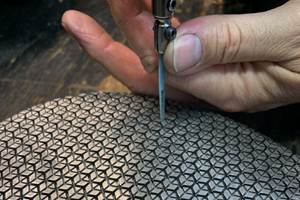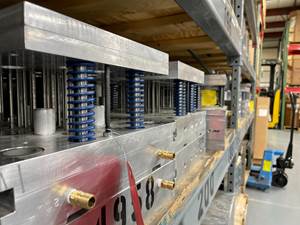Steel Choice Matters for Corrosion Resistance
A free-machining stainless steel faces the extremely corrosive injection molding environment head on, improving machinability and stability.
Tool steel resists condensation, and waterline corrosion, which is especially important as the use of corrosive materials like fire-retardant additives, PVC and aminoplast increases. However, with every positive there is typically a negative. For example, corrosion-resistant plastic injection mold steels require additional machining time that increases wear, and more complex mold bases cause 60 percent of the steel to become chips.
To address these challenges, steel suppliers continue to develop specialty steels to combat the extremely corrosive injection molding environment while improving steel’s machinability and stability. For example, a free-machining stainless steel that offers a balance between machinability and corrosion resistance by combining a special chemical composition with a special heat-treatment process.
Low-carbon content and alloying elements such as chromium, manganese, and other additions play an important role in this free-machining stainless steel. The alloying elements are added during production and combine to yield optimal hardness, machinability and corrosion resistance (see Table 1).
| C | Si | Mn | S | Cr | Additions |
|---|---|---|---|---|---|
| 0.05 | 0.40 | 1.30 | 0.15 | 12.50 | + |
Table 1. Chemical composition in weight-%.
The heat treatment process further refines the steel at the final production process. The material is heated to a temperature of 1,475°F under controlled conditions and quenched in water or a polymer, which promotes the characteristic of a homogenous microstructure yielding material that is consistent throughout and extremely stable.
To assess corrosion resistance and determine the appropriate testing method, the mold builder must understand the type of corrosion that may occur. The corrosion behavior is a system property. The corresponding tests only reveal the classification of the steels in the same testing structure. Several tests were conducted on this free-machining stainless steel in laboratory conditions with media containing chloride, condensation and in slightly acidic conditions. A sulfur-alloyed steel was tested for comparison. The results indicated that the free-machining steel and the sulfur-alloyed steel are nearly identical in corrosion resistance. The free-machining steel also offers an increase in cost-effectiveness and productivity by decreasing machining cost and lead times (see Figure 1).

Figure 1. Comparing machinability in % (sulfur-alloyed steel 325 HB, free-machining stainless steel 370 HB).
To optimize machining efficiencies and lead times, refer to the process recommendations in Table 2.

Table 2. Machining values for free-machining stainless steel (hardness 290 - 332 HB)
Mold material choice is one of the key variables influencing plastic part production profitability, so it may be time to consider the machinability, dimensional stability and weldability benefits of a free-machining stainless steel, which can also enhance mold performance with its toughness, minimal residual stresses, and good corrosion resistance.
Related Content
How to Polish Ribs for Proper Part Release
Using the right tools and abrasives is essential to polish a mold to the required final finish.
Read MoreFive Benefits of Aluminum Tooling
Aluminum molds are worth a second look as a viable means to swiftly and cost-effectively get products to market.
Read MoreThree Good Reasons to Switch from Three- to Five-Axis Machining in Moldmaking
Five-axis machining technology is a great tool in the moldmaker toolbox.
Read MoreReasons to Use Fiber Lasers for Mold Cleaning
Fiber lasers offer a simplicity, speed, control and portability, minimizing mold cleaning risks.
Read MoreRead Next
Overcoming Pain Points in Moldmaking with AI
Shops that embrace AI as a tool, not a threat, can enhance efficiency, preserve expertise, and attract tech-savvy talent.
Read MoreHow to Use Strategic Planning Tools, Data to Manage the Human Side of Business
Q&A with Marion Wells, MMT EAB member and founder of Human Asset Management.
Read MoreYour Guide to Smarter, Faster Mold Design
Dive into expert-curated content delivering proven solutions for mold optimization, manufacturability and precision performance.
Read More




















